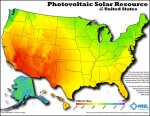zog
Senior Member
- Location
- Charlotte, NC

Hey guys, been trying to educate myself on residential solar systems on "that other forum" but can't seem to get any technical answers (Just insults). So I find this attached map interesting and want to be sure I am understanding this all correctly.
If we look at an average area for the east coast of 4kWh/m^2/Day and divide that by 24 hours we get 166 W/M^2 right?
And the panels I looked at that claim to be some of the most advanced for residentail usage have ratings of around 150W @ 800W/M^2. Is that correct?
So if we have an average W/M^2 rate of 166 W/M^2 in a area (I assume this average is night and day, acoss a year) we can estimate the output of this panel to be a little over 31 watts over the course of a year. And if I put 6 of these panels on my roof I would produce an average of 186 watts, and 4.46kWh per day?
I am really trying to learn here so please correct me if I am wrong. This is interesting stuff, I get that there are peak production times, which just so happens to be peak usuage times for residential systems, and looking at that solar seems to be a better future replacement for gas fired peaker plants than base load plants. But for now I just want to make sure I am looking at the average output of a typical panel correctly.
Last edited:

